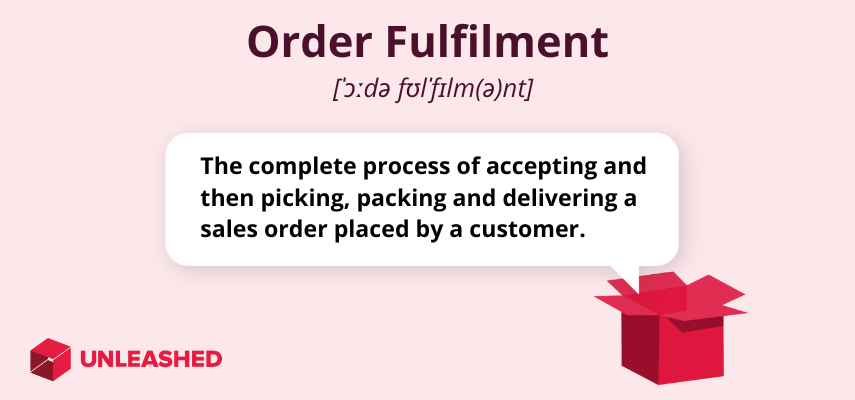
Ecommerce consumers want fast, accurate deliveries and a transparent purchasing process. When it comes to customer service, how you manage your WooCommerce order fulfilment plays a vital role in meeting customer expectations.
In this guide, we break down the WooCommerce order fulfilment process and how it works, with actionable tips for optimising your fulfilment strategy to bring costs down and boost productivity. Before we dive into the details, let’s run through a quick overview.
What is WooCommerce order fulfilment?
WooCommerce order fulfilment refers to the processes involved in completing customer orders through an online WooCommerce store. It includes tasks such as managing inventory, packing and shipping customer orders, and processing returns.

The WooCommerce order fulfilment process
Fulfilling orders on WooCommerce follows a similar process to other sales channels, such as Shopify or Amazon. We’ve covered those steps below, but if you’re already familiar with the ecommerce order fulfilment process, feel free to skip straight to fulfilling orders specifically through WooCommerce.
1. Procurement and purchasing
Before goods can be sold and delivered to customers, they must be produced, acquired, and prepared for sale. Procurement is the process of sourcing the suppliers and service providers that enable you to sell products.
In a manufacturing setting, this step involves the purchasing of raw materials and production equipment. For a retailer, this can mean sourcing bulk goods directly from wholesalers or manufacturers.
In either case, efficient demand forecasting plays a critical role in bringing costs down and reducing waste. Use it to identify optimal order volumes for the items you require based on predicted future sales.
2. Inventory management
An optimised inventory management strategy will facilitate better WooCommerce order fulfilment by making it easier to find stocked items inside your facilities.
Implement a warehouse or shop layout that’s designed to help order pickers quickly find and transport popular items. Then use a perpetual inventory management system to streamline and automate your manual stock control processes for even greater time savings.
When your recorded stock levels are accurate and your warehouse is sufficiently organised, the risks and costs associated with order fulfilment are greatly reduced.
3. Order management
Order management is the process of receiving, processing, and fulfilling your WooCommerce orders.
When someone purchases something through your WooCommerce store, you need a system that ensures the order details are recorded and delivered to the warehouse. Once an order has been processed, the items also need to be picked, packed, and shipped.
WooCommerce order fulfilment can be done manually – using traditional spreadsheet- or paper-based systems – or automatically, using order fulfilment software.
While WooCommerce’s out-of-the-box order management features may suffice for a small business, there are plenty of plug-ins and tools you can use to improve the process.
4. Shipping and communication
Once a customer order has been picked and prepared for shipping, the goods should be checked for accuracy. In most cases, WooCommerce merchants will hire a third-party service provider to collect the goods and deliver them to the customer.
However, the order fulfilment process doesn’t end when an order leaves the warehouse.
58% of customers expect businesses to follow up with them post-purchase, according to a study by McKinsey. A similar number (59%) expect to be communicated with after key moments – for example, when an order has been shipped or tracking information is updated.
The same research found that customers were more likely to shop from a brand and recommend it to their friends if they were satisfied with the level of communication they received.
Take time to create a strategy and guidelines for communicating order statuses and updates with your customers. You can streamline the customer support process by creating templated responses to common queries and setting up automated email flows that only need slight tweaking for each customer.
5. Returns management
The return rate for some retail sectors is as high as nearly 20%. No matter how good your products are, some of them will come back and you’ll be expected to deal with them quickly.
Returns management is the process of ensuring your business is set up to manage customer returns and issue refunds as required.
The reason for an order being returned should be recorded and may influence a revision of your processes. When an item comes back from a customer it will need to be inspected for quality and to confirm it matches the item shipped. A replacement item or refund will need to be processed, and a confirmation of the resolution should be sent to your customer.
If goods are returned because they are faulty, you should inspect all stock of that item and the process for producing or handling it. If an order was picked incorrectly and the wrong items were received, look at your stock control processes and consider implementing a barcode scanning system to improve order accuracy.

WooCommerce order fulfilment methods
There are four common methods for fulfilling WooCommerce orders:
- In-house order fulfilment
- Third-party order fulfilment
- Dropshipping
- Hybrid
Let’s quickly dive into how each of these methods works.
1. In-house order fulfilment
In-house order fulfilment, also called merchant fulfilment, is where a business is responsible for some or all of the fulfilment process. This typically requires storage facilities and systems for managing inventory, along with enough staff to process and complete orders quickly.
Many WooCommerce businesses start this way. But as your business grows, you may decide to involve external parties to help with specific processes.
The benefits of in-house WooCommerce order fulfilment include being able to personalise the customer experience and retain full control over how their orders are received, managed, and delivered.
2. Third-party order fulfilment
Third-party order fulfilment, also called third-party logistics (3PL), is a fulfilment method whereby an external service provider is hired to manage some or all the physical elements of running your WooCommerce business.
Some of the tasks that can be managed by a 3PL provider include:
- Receiving
- Inventory management
- Inventory storage
- Order fulfilment
- Shipping
- Procurement
- Purchasing
- Customer service
- Returns management
While this method frees up a lot of time and storage space to be put to other uses, 3PL fees can dig into your margins and give you less control over how orders are being fulfilled.
If your sales volume is growing faster than you can manage it, turning to a 3PL for help can also be a good (if expensive) way to keep up until you have the time and money to put better internal systems in place.
3. Dropshipping
Dropshipping is a WooCommerce order fulfilment method that doesn’t require storage facilities or a third-party fulfilment company. Instead, orders are shipped directly from your suppliers to your customers’ addresses.
Following the dropshipping method, whenever a customer places an order, the retailer then places their own order with the supplier using the customer’s address as the shipping destination. The retailer never actually sees or touches the product.
This is a low-cost way to run a WooCommerce business. However, it comes with a few downsides.
For starters, you won’t have any control over the accuracy of your orders, how they’re shipped, and fulfilment times. There is also no opportunity to quality test products before they arrive with your customers. And if a customer changes their mind after an order has been shipped, the returns process can be more tedious – and more expensive.
4. Hybrid approach
It’s also possible to mix and match WooCommerce order fulfilment methods for a bespoke solution suited to your requirements. This approach is known as the hybrid method.
For example, you might hold stock of a few core products. These could be your bread-and-butter items, or perhaps a specialty item that can’t be reliably managed by an external company.
When a customer places an order for one of these items, you manage fulfilment in-house. But if you wanted to sell items you don’t currently have the capacity or appropriate equipment required to store onsite, you would rely on ecommerce fulfilment service providers or dropshipping to fulfil the remaining orders.
Now that we’ve discussed the methods for fulfilling WooCommerce orders, let’s turn our attention to the platform itself – and how to manage order fulfilment from within your WooCommerce app.
How to fulfil orders in WooCommerce
WooCommerce order fulfilment starts and ends in your WooCommerce dashboard.
If you haven’t already set up your WooCommerce store, we recommend using the WooCommerce setup wizard to get that sorted first. You can access the setup wizard by going to Settings > Help > Setup Wizard in your WooCommerce dashboard.
Step 1: View current orders
The first place you’ll need to look to manage your WooCommerce orders is the Orders management page. To get there, select WooCommerce > Orders from your dashboard.
Each time a customer places an order in your store, WooCommerce will automatically add a new line item to this list.
From the orders management tab, you can find:
- Order number
- Customer name
- Order date
- Order status
- Billing address
- The value of each sale
- Current actions
To view more details about a specific order, click on the customer’s name.
Step 2: Prepare the items for shipping
Once you’re ready to fulfil an order, select it from your WooCommerce dashboard.
You’ll be able to see which products and quantities have been ordered, along with any important details such as shipping address and contact information. Depending on the size of your operation, you may need to communicate the specific order details with your warehouse picking staff.
If you’ve already got the Unleashed inventory management plugin for WooCommerce, the order information will automatically flow into your Unleashed account. From here, you can find product locations and quantities, update stock levels, and synchronise the information to your accounting system with just a few clicks.
If you’re relying on manual systems (for example, an Excel spreadsheet) to track inventory and orders you’ll need to spend a few minutes updating all this information yourself.
Once you’ve picked the items for your order and packed them into a box, create a shipping label using either manual labels or a WooCommerce shipping label.
Step 3: Update order status
As a customer’s order passes through the system to the fulfilment team, then the carrier for delivery, it’s important that you update the order status in WooCommerce.
This step ensures that customers are kept informed of the status of their order, allowing you to manage their expectations with fewer communications. It also provides a way for you to keep track of all your outgoing orders.
Visit Settings > Emails in your WooCommerce dashboard to set up custom email alerts for each stage of the order fulfilment process. These email alerts are quite basic, but there are also plugins you can use instead.

How to optimise your WooCommerce order fulfilment process
We’ve covered the basics of WooCommerce order fulfilment. But before we wrap things up, let’s look at a few actionable tips you can use to overcome common order fulfilment challenges boost the success and efficiency of your fulfilment process.
1. Prioritise clear communication
Each link in the supply chain – from the manufacturer to your delivery driver – relies on timely updates to perform their job well. When procuring suppliers and service providers, work out your methods of communication and stick to them. This will help to improve supplier relationships.
Equally important: Set up automated customer emails notifying them of their order status throughout various stages of the fulfilment process. Display how they can get in touch with you clearly on your WooCommerce website and try to respond to all queries within a couple of days.
2. Implement perpetual inventory management
Efficient inventory management is essential for growing ecommerce stores, especially when you start expanding into multichannel retailing or require multiple warehouses to store your goods.
A perpetual inventory management system ensures your recorded inventory levels are constantly updated and always accurate. Use it to set up automatic reorder points so you know when stock is getting low; track key details like supplier information, customer discounts, Bills of Materials, and product details; and monitor the performance of your business through valuable data analysis.
3. Streamline your returns process
If you aren’t equipped to handle returns and refunds, it’s going to bog down your admin staff and frustrate customers who are waiting for their money (or a new replacement item).
Refunds can be issued from your WooCommerce dashboard in the Orders screen by clicking on the applicable order and selecting Refund.
Develop a system for managing and completing customer returns. This process should include customer communications, a quality inspection of the returned goods, and refund processing.
Does WooCommerce have an inventory management system?
Yes, WooCommerce has a basic inventory management system. You can enable this in your Inventory settings under the Products tab. While WooCommerce inventory management lacks many of the key features of dedicated inventory software, you’ll be able to enter your product details and track stock levels from within the dashboard.
Limitations of WooCommerce inventory management:
- Limited stock notifications
- It can’t handle large databases
- It can’t track inventory across multiple locations
- It doesn’t support raw materials
- Products must be updated individually
These limitations may not be a problem for new or smaller businesses with limited stock. However, successful and growing firms should look for an inventory management plugin like Unleashed for more control over their inventory.
Best order fulfilment plugins for WooCommerce
There are dozens of tools you can use to make WooCommerce order fulfilment less arduous.
The table below offers a few solutions for improving your fulfilment process.
|
WooCommerce shipping plugins |
|
|---|---|
|
Dropshipping plugins |
|
|
Inventory management plugins |
